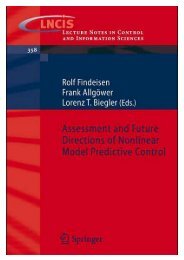The Stability of Linear Feedback Systems
The Stability of Linear Feedback Systems
The Stability of Linear Feedback Systems
Create successful ePaper yourself
Turn your PDF publications into a flip-book with our unique Google optimized e-Paper software.
5.2 <strong>The</strong> Routh·Hurwitz <strong>Stability</strong> Criterion 211<br />
der to ascertain the stability <strong>of</strong> a feedback control system, one could<br />
In ~re the roots <strong>of</strong> the characteristic equation q(s). However, we are first<br />
deIt..nu~ in determining the answer to the question: "'s the system stable" If<br />
iD1t::t late the roots <strong>of</strong> the characteristjc equation in order to answer this ques<br />
~ Cll have determined much more information than is necessary. <strong>The</strong>refore,<br />
IiCJIl. ~methods have been developed which provide th@ required "yes" or "no"<br />
JIVCI'I.. 10 the stability question. <strong>The</strong> three approaches to the Question <strong>of</strong>stability<br />
~) <strong>The</strong> s-plane approach, (2) the frequency plane Uw) approach, and (3) the<br />
~omain app~oach. <strong>The</strong> ~eal frequ~ncy (jw) ap~roach is oullin.ed in Chapter<br />
..aad the discussion <strong>of</strong> the ttme·domalO approach IS deferred uniii Chapter 9.<br />
• <strong>The</strong> Routh-Hurwitz <strong>Stability</strong> Criterion<br />
']"be discussion and determination <strong>of</strong> stability has occupied the interest <strong>of</strong> many<br />
_neers. Maxwell and Vishnegradsky first considered the question <strong>of</strong> stability<br />
<strong>of</strong>dynamic systems. In the late 1800s, A. Hurwitz and E. J. Routh published<br />
iDdePendently a method <strong>of</strong> investigating the stability <strong>of</strong> a linear system [2, 3].<br />
<strong>The</strong> Routh-Hurwitz stability method provides an answer to the Question <strong>of</strong> stability<br />
by considering the characteristic equation <strong>of</strong> the system. <strong>The</strong> characteristic<br />
equation in the laplace variable is written as<br />
6(s) = q(s) = a"sn + on_Is"-1 + ... + ajs + au ::: O. (5.3)<br />
III order to ascertain the stability <strong>of</strong>the system, it is necessary to determine ifany<br />
<strong>of</strong> the roots <strong>of</strong> q(s) lie in thc right half <strong>of</strong> the s-plane. If Eq. (5.3) is written in<br />
6ctored form, we have __<br />
an(s - ,\)(s - (2) ..• (s - 'n) = 0, (5.4)<br />
Where" ... ilh root <strong>of</strong>the characteristic cquation. Multiplying the factors togcther<br />
we find that<br />
'<br />
q(s) = a"s" -<br />
a"(rl + 'z + ... + 'n)s"-I<br />
+ a.('I'2 + rZr J + 'I') +. .)s"-2<br />
- a"(rl,Z') + 'Ir z ,.' •)sn-J +<br />
L + an( -IY",z') . 'n = O.<br />
All other Wo d l'.<br />
r S, lor an nth-degree equation, we obtain<br />
q(s) '"' a"s" -<br />
an(sum <strong>of</strong> all the roots)s"-I<br />
(5.5)<br />
+ an(sum <strong>of</strong>lhe products <strong>of</strong> the roots taken 2 at a time)s"-z<br />
- a"(sum <strong>of</strong>the products <strong>of</strong> the roots taken 3 at a time)s"-J<br />
(5.6)<br />
Eta + ... + a"(-!)"(product <strong>of</strong>all II roolS) = O.<br />
mining Eq (5 5) . .<br />
e the same . '.' ,we note that .a11 the coeffiCients <strong>of</strong> the polynomial must<br />
sign Ifall the roots are In the left-hand plane. Also, it is necessary










![[Language - English] - Life Skills - Writing](https://img.yumpu.com/44143758/1/190x245/language-english-life-skills-writing.jpg?quality=85)





